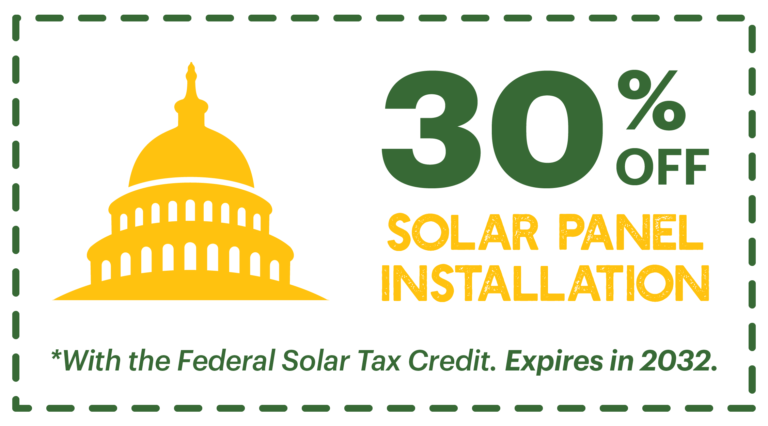Welcome to the hassle-free guide on claiming your Federal Tax Credit for solar! If you’ve recently installed solar panels and want to maximize your tax savings, you’re in the right place. In this walkthrough, we’ll show you how to easily claim your full solar tax credit using TurboTax. Whether you’re a seasoned tax filer or new to the process, our step-by-step instructions will ensure that you navigate through the complexities of tax filing with ease. So, let’s dive in and make the most of your solar investment! If you are not using Turbotax and instead filing manually, see our article here for filing using Form 5695.
First, a quick disclaimer:
This guide is offered as basic instruction only and is not meant as professional tax preparation advice. We recommend consulting a certified tax preparation specialist or CPA for specific tax-related questions or issues.
In this guide, we will cover only claiming your solar tax credit through TurboTax. A great resource is the Office of Energy Efficiency and Renewable Energy’s Guide to the Federal Tax Credit for Solar or our other article here.
What You’ll Need:
- Your solar cost, which is found on your solar contract
- 10-15 minutes
1. This is probably the easiest step. Login to Turbotax.
2. Review your personal information and make any updates.
This includes your name, SSN, and date of birth. Most of this information will not change of course, but ensure that fields like ‘Occupation or job title’ have not changed since the last year.
3. Update your Wages & Income.
- This section may take you the longest to complete given it may have changed in the previous year. This includes but is not limited to your salary/wages, investments/savings, self-employment, etc.
- Tip: TurboTax allows you to upload pictures of your W2 which may save you time!
4. Review your tax breaks.
- This is the fun part! We recommend adding all your other tax breaks first, but it really doesn’t matter. This can include mortgage and interest (Form 1098), Property Taxes, Child and Other Dependent Tax Credits, and many others. As usual, please consult your tax advisor!
- After finishing, select the ‘See all tax breaks’ button.
5. Type in ‘Energy’ and select ‘Start’ or ‘Revisit’.
6. On the next page, select ‘Yes’ to move forward.
7. Next, it will ask if you shared the home with another person. If you own the house where the solar system is, select ‘No, the home is mine’.
8. Next, select ‘Yes, my home is in the United States’. After, select whether or not the improvements were on your main home or not. Finally, select “No, the improvements weren’t related to the construction of my main home.” A solar system is not considered part of the construction of a home!
9. After selecting ‘Continue’ the form will ask about typical home improvement upgrades for your home. If you just got solar, you can skip this page and select ‘Continue’.
10. The next page asks if you have any energy credits in prior years. If this is your first year, select ‘No’.
11. Finally, enter the cost of your solar system at the ‘Solar electric cost’. This can be found on your contract.
12. The next question pertains to a carryforward. This is in the event you can’t collect the full tax credit in one year. If this is the first year you apply, you can select ‘No, I did not’.
13. Finally, you will get a Home Energy Credit Summary. This should be 30% of the total cost in most cases.
That’s it! You’ve successfully navigated through the process of claiming your Federal Tax Credit for solar using TurboTax. By following these simple steps, you’ve ensured that you’re getting the full credit you’re entitled to for your solar investment. Now, all that’s left to do is finish up your taxes, knowing that you’ve taken advantage of this valuable credit. Remember, if you have any specific tax-related questions or concerns, it’s always a good idea to consult with a certified tax preparation specialist or CPA. Happy filing!
Incentives in St. Mary’s County
Federal Tax Credit: The federal tax credit for solar lets you deduct 30% of the cost of a solar system installed between 2022-2032 from your federal income taxes. This means that if your solar system costs $50,000, you can save $15,000 immediately.
MD Residential Clean Energy Rebate: If the solar is placed on your primary residence, you are eligible for a $1,000 check from the State of Maryland!
Solar Renewable Energy Credits: Your system will produce electricity, measured in kilowatt-hours (kWh). For every 1,000 kWh that you produce, you will receive one Energy Credit. These credits are currently being sold for around $50-$60. Over the course of 30 years, a typical solar system lifetime, you will make thousands of dollars!
Net Metering: During the day, when their solar panels generate excess electricity, it flows back into the grid, spinning your meter backwards and earning credits. These credits can be used to offset the cost of electricity consumed from the grid at night or on cloudy days, effectively lowering your overall electricity bill and potentially even eliminating it entirely.
Sales Tax Exemption: This exemption excludes solar systems from having a sales tax, reducing the overall cost of the system.
Property Tax Exemption: Solar systems are exempt from state and local property taxes! Essentially, this means that your property taxes cannot increase due to the installation of your residential solar panels.


